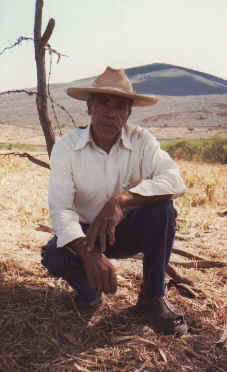 Chayanov used the same basic statistical data as Lenin, but he offered a quite different explanation for the patterns of differentiation which Lenin saw as the development of rural capitalism. We've seen that the amount of work done by the working members of a peasant family in the Chayanovian model is a function of the family's consumer-worker ratio. We've also examined some specific predictions made by Chayanov about peasant behaviour in the face of shortage of land: in particular the ‘hunger rents’ principle. If we put these two things together, then we can see the economic activity of any given peasant family is likely to display a cyclical pattern over time.
Chayanov used the same basic statistical data as Lenin, but he offered a quite different explanation for the patterns of differentiation which Lenin saw as the development of rural capitalism. We've seen that the amount of work done by the working members of a peasant family in the Chayanovian model is a function of the family's consumer-worker ratio. We've also examined some specific predictions made by Chayanov about peasant behaviour in the face of shortage of land: in particular the ‘hunger rents’ principle. If we put these two things together, then we can see the economic activity of any given peasant family is likely to display a cyclical pattern over time.
Chayanov argued that children under twelve years of age made little effective contribution to the farm as workers. So after a peasant couple have started their family, there is a long period during which their consumer-worker ratio deteriorates: there are more mouths to feed, and new unproductive children are still being born even after the oldest child has started working. In order to cope with this pressure from the consumption needs of the family, the working members must produce more, and they can do this in two ways:
- They can work harder, i.e. for longer hours, increase their rate of 'self-exploitation'
- They may also do things which Lenin interpreted as evidence of proto-capitalism: i.e. they may rent more land, buy livestock and equipment and perhaps even hire a few extra workers, simply because there are more mouths to feed and they need to expand production.
In many cases, they may do both.
Expansion in terms of renting more land, buying plough teams and hiring labour could not be interpreted as ‘proto-capitalism’ on Chayanov's model, since it would only be a temporary phase in the development cycle of a peasant family. As the number of children who work increases over time, use of hired labour will stop. Later on, as the children begin to grow up and marry, the household will divide, and the level of economic activity on the part of the parental generation will slacken off, until the original couple grow old and either die or merge into another household, usually that of one of their married children. So peasant family farms will move through a cycle of growth and contraction. If total rural population is in fact growing, then official statistics will record a net growth in the number of ‘expanded’ enterprises. But this would not represent the emergence of a new agrarian class structure: in time, for most households, expansion would be followed by contraction.
So Chayanov's theory ultimately explains socio-economic differentiation among the peasantry in terms of demographic variation between families: only biology ultimately determines the size and capitalisation of the farm. Chayanov simply assumed that peasants aim to secure a minimum standard of livelihood and do not attempt to expand production further once family needs have been satisfied. He did not supply any independent proof that this assumption was justified in the Russian case. But Chayanov might actually have been correct to argue that no strong class polarisation was developing among the Russian peasantry even if his explanation for why that was so was wrong or inadequate. There were, in fact, other factors determining the socio-economic position of Russian peasant households besides the demographic factors and changes in consumer-worker ratios on which Chayanov himself based his analysis. These other factors could have produced the effects Chayanov predicted.
Teodor Shanin has argued that pre- and post-revolutionary Russian peasant households typically had very limited resources of land, labour and farm equipment, and even more limited money savings and access to credit. Russian climatic conditions made harvests very variable from year to year. Market prices for peasant grain fluctuated widely. Finally, various policies which first the Tsarist and then the early Bolshevik state adopted to promote Russia's industrialization had a very damaging effect on peasant incomes, because they led to price rises for things Russian peasants bought on the market without a corresponding increase in the price of the grain they sold to raise cash. Shanin argues that the effect of all these problems facing peasant farmers was to make individual family farms very vulnerable to crisis. It was largely a matter of luck if an individual middle peasant family prospered and became a kulak household, or a poor family made it into the middle peasantry. Furthermore, a family's luck might change, and even rich peasant households would have large numbers of children: so the family's ‘capital’ would have to be divided up among the next generation. Rich families tended to move downwards too. So tendencies towards class polarization were offset by these multidirectional cyclical tendencies, these movements up and down. In the end, class polarisation was limited by the fragility of the Russian peasant economy, that is the unfavourable conditions facing all peasant producers.
Shanin's argument, we should note, doesn't reject the idea that kulaks were trying to accumulate wealth. All Shanin argues is that it was really very difficult for peasants to succeed in sustaining accumulation of capital in the longer term.